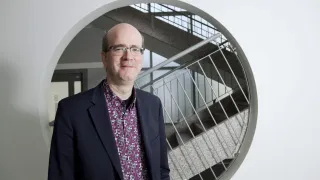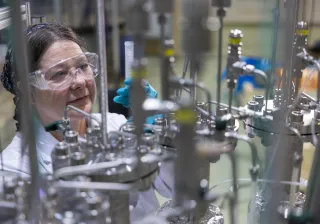VTT Research Professor Mark van Gils predicts that the rapid development of AI will revolutionise processes such as the diagnosis of brain injuries and treatment recommendations. At the same time, the healthcare focus will gradually shift from treatment to proactive, individualised healthcare.
Artificial intelligence is a talking point everywhere. Today, it is almost impossible to browse a newspaper or read a blog that does not at least mention AI. Why is artificial intelligence such a hot topic right now – not least among researchers developing artificial intelligence technology and applications for the health sector?
A VTT Research Professor sees three main drivers behind this. First, there is the huge amount of health data available from various sources. More such data is accumulating all the time. From maternity wards onwards, every customer visit to a health centre, private clinic, and general hospital is in principle recorded and the data can be stored for possible further use.
Additionally, health-related data is now easy to gather by various other means: the smartwatch is an example of a sensor that gathers an immense amount of data on its user. On the other hand, social media usage patterns reveal a great deal about people. Do you spend a lot of time on Facebook, for example, in the late hours, leading to too little sleep for the sake of your health?
– A range of patient data is already available; data on what a person is like, their background, are there other illnesses and, for example, is there a greater risk of developing a disease due to genetic reasons, says van Gils.
Patient data from many sources
Van Gils emphasises that, in addition to the quantitative growth in the available data, data-analysis algorithms have been making very rapid progress in recent years. This will also take the development of health-sector AI applications forward by leaps and bounds.
The rapid development of computer systems and huge increase in capacity – which, according to Moore's law, doubles every eighteen months – is also helping.
– In the past, algorithms were intelligent and capable of learning, but the problem lay in their low speeds. Computer experts and mathematicians have done a tremendous job in speeding up algorithms. Today, a range of complex issues, including those related to patient health, can be solved within a reasonable time – in hours, minutes, or even seconds, rather than in years as before.
The right support, for the right person
According to van Gils, there is enormous potential for exploiting artificial intelligence, particularly in the health sector where the main objective is to shift to a preventive care approach. Artificial intelligence applications have already been developed to meet the needs of the sector. The number of new applications will only grow as the technology develops and new, gene-related causes of diseases are identified.
VTT is studying the suitability of AI for tasks such as streamlining diagnosis and treatment plans for patients with brain injuries. Mark van Gils estimates that, in around 2–4 years, doctors will be using AI-based prototypes to help them with tasks such as diagnosis. However, before the technology can be introduced in daily patient care, years of development and preparation will be needed in areas such as legislation, open questions concerning patient data (e.g. privacy protection), and the integration of patient data from various sources.
He points out that giving the right treatment, during the critical hours following an accident involving a brain injury, is crucial for the patient's rehabilitation. However, diagnoses can be very difficult due to the complex nature of the brain and the unique character of the injuries. Help is being sought from AI to solve this problem among others.
– The tool under development by VTT will enable the combination of hundreds of data sources and the visualisation of a brain injury patient's overall condition. It will also help doctors to better understand what should be done to aid the patient's recovery.
Doctors will remain necessary
And how will the application of AI show in practical patient care – will the health centres of the future need doctors at all, or will they gradually be replaced by robots?
Van Gils explains that doctors will retain their status as the person responsible for patient care despite advances in AI.
– The doctor is the key person who understands the patient's overall situation and what kind of treatment they need. This too will continue to be the case. In the future, doctors will have more patient information at their disposal. For example, your doctor will know about the background of the patient, the circumstances in which they were injured and their risk of falling ill with various diseases.
The large database available to physicians will serve as a benchmark, a reference for the patient's situation.
– For example, data analysis can be used to determine issues such as what kind of rehabilitation programme is best suited to a patient's individual needs.
Genetic research gaining momentum
The shift in the focus of healthcare from treating diseases to proactive care is just beginning. However, some diseases are perhaps already more predictable than others. For example, type 2 diabetes develops due to a combination of lifestyle and genetic factors. The current thinking is that genetic predisposition is particularly related to the regulation of insulin excretion, whereas environmental factors, such as lifestyle, mainly affect the development of insulin resistance.
– In the treatment of brain injury patients, the development of AI will impact on areas such as the provision of tailored rehabilitation programmes alongside conventional recommended treatments.
According to van Gils, genetic research and the development of gene banks are the next step on the road to preventive health care. Global progress is being made in the field of gene research and new correlations are continuously being sought and found between genetic factors and the risk of developing diseases.
However, there is still a long way to go in preventive health care – dozens of years.
– This is an unavoidable, if long, path. As the population ages, the number of long-term and multiple illnesses will grow and healthcare costs will rise. How will the money and resources be found for this?
The Research Professor stresses that current healthcare practices, by which diseases are treated only after they have emerged, is costly for both society and patients.
– In this context, anticipating and, at best, completely preventing illnesses would have a major impact on wellbeing.




